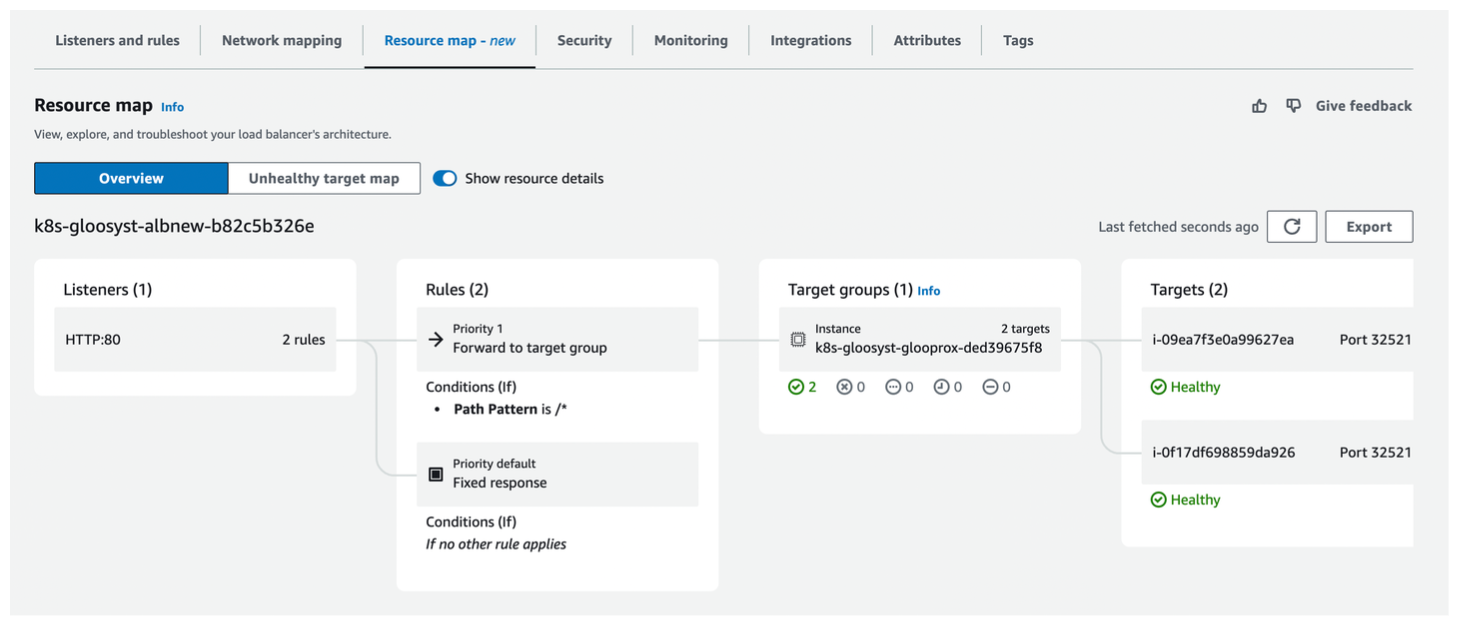AWS ALB
In this guide you explore how to expose the K8sGateway proxy with an AWS application load balancer (ALB).
Keep in mind the following considerations when working with an ALB:
- The AWS Load Balancer Controller only supports creation of an ALB through an Ingress Controller and not through the Kubernetes Gateway API. Because of this, you must create the ALB separately and later connect it to the service that exposes your gateway proxy.
- K8sGateway does not open any proxy ports until at least one HTTPRoute resource is created that references the gateway. However, AWS ELB health checks are automatically created and run after you create the gateway. Because of this, registered targets might appear unhealthy until an HTTPRoute resource is created.
Before you begin
- Create or use an existing AWS account.
- Follow the Get started guide to install K8sGateway and deploy the httpbin sample app. You do not need to set up a Gateway as you create a custom Gateway as part of this guide.
Step 1: Deploy the AWS Load Balancer controller
-
Save the name and region of your AWS EKS cluster and your AWS account ID in environment variables.
export CLUSTER_NAME="<cluster-name>" export REGION="<region>" export AWS_ACCOUNT_ID=<aws-account-ID> export IAM_POLICY_NAME=AWSLoadBalancerControllerIAMPolicyNew export IAM_SA=aws-load-balancer-controller -
Create an AWS IAM policy and bind it to a Kubernetes service account.
# Set up an IAM OIDC provider for a cluster to enable IAM roles for pods eksctl utils associate-iam-oidc-provider \ --region ${REGION} \ --cluster ${CLUSTER_NAME} \ --approve # Fetch the IAM policy that is required for the Kubernetes service account curl -o iam-policy.json https://raw.githubusercontent.com/kubernetes-sigs/aws-load-balancer-controller/v2.5.3/docs/install/iam_policy.json # Create the IAM policy aws iam create-policy \ --policy-name ${IAM_POLICY_NAME} \ --policy-document file://iam-policy.json # Create the Kubernetes service account eksctl create iamserviceaccount \ --cluster=${CLUSTER_NAME} \ --namespace=kube-system \ --name=${IAM_SA} \ --attach-policy-arn=arn:aws:iam::${AWS_ACCOUNT_ID}:policy/${IAM_POLICY_NAME} \ --override-existing-serviceaccounts \ --approve \ --region ${REGION} -
Verify that the service account is created in your cluster.
kubectl -n kube-system get sa aws-load-balancer-controller -o yaml -
Deploy the AWS Load Balancer Controller.
kubectl apply -k "github.com/aws/eks-charts/stable/aws-load-balancer-controller/crds?ref=master" helm repo add eks https://aws.github.io/eks-charts helm repo update helm install aws-load-balancer-controller eks/aws-load-balancer-controller \ -n kube-system \ --set clusterName=${CLUSTER_NAME} \ --set serviceAccount.create=false \ --set serviceAccount.name=${IAM_SA}
Step 2: Deploy your gateway proxy
-
Create a Gateway resource with an HTTP listener.
kubectl apply -n gloo-system -f- <<EOF kind: Gateway apiVersion: gateway.networking.k8s.io/v1 metadata: name: alb spec: gatewayClassName: gloo-gateway listeners: - protocol: HTTP port: 8080 name: http allowedRoutes: namespaces: from: All EOF -
Create an HttpListenerOption resource to change the default health check path for the gateway proxy. This step is required to ensure that the ALB health checks pass successfully.
kubectl apply -f- <<EOF apiVersion: gateway.solo.io/v1 kind: HttpListenerOption metadata: name: alb-healthcheck namespace: gloo-system spec: targetRefs: - group: gateway.networking.k8s.io kind: Gateway name: alb options: healthCheck: path: "/healthz" EOF -
Use an Ingress resource to create your ALB. Make sure to include the health check path that you set up earlier.
kubectl apply -f- <<EOF apiVersion: networking.k8s.io/v1 kind: Ingress metadata: namespace: gloo-system name: alb annotations: alb.ingress.kubernetes.io/scheme: internet-facing alb.ingress.kubernetes.io/target-type: instance alb.ingress.kubernetes.io/healthcheck-protocol: HTTP #--HTTPS by default alb.ingress.kubernetes.io/healthcheck-path: "/healthz" spec: ingressClassName: alb rules: - http: paths: - path: / pathType: Prefix backend: service: name: gloo-proxy-alb port: number: 8080 EOFℹ️If you later change your Ingress resource configuration, you might need to delete and re-create your Ingress resource for AWS to pick up the changes. -
Review the load balancer in the AWS EC2 dashboard.
- Go to the AWS EC2 dashboard.
- Go to Load Balancing > Load Balancers. Find and open the ALB that was created for you.
- On the Resource map tab, verify that the load balancer points to targets in your cluster.
ℹ️K8sGateway does not open any proxy ports until at least one HTTPRoute is associated with the gateway. The AWS ELB health checks are automatically created when you create the Gateway resource and might report that the gateway proxy is unhealthy. Continue with this guide to create an HTTPRoute resource to open up a port in the ALB. -
Create an HTTPRoute resource to open up a port on the gateway proxy. This step is required for AWS ELB health checks to pass.
kubectl apply -f- <<EOF apiVersion: gateway.networking.k8s.io/v1 kind: HTTPRoute metadata: name: httpbin-alb namespace: httpbin labels: example: httpbin-route spec: parentRefs: - name: alb namespace: gloo-system hostnames: - "albtest.com" rules: - backendRefs: - name: httpbin port: 8000 EOF -
Go back to the AWS EC2 console to verify that the AWS ELB checks now pass.

Test the ALB
-
From the AWS EC2 console, get the DNS name that was assigned to your ALB and save it as an environment variable.
export INGRESS_GW_ADDRESS=<alb-dns-name> -
Send a request to the httpbin app. Verify that you get back a 200 HTTP response code.
curl -vik http://$INGRESS_GW_ADDRESS:80/headers -H "host: albtest.com:80"Example output:
... < HTTP/1.1 200 OK HTTP/1.1 200 OK
Cleanup
You can remove the resources that you created in this guide.kubectl delete ingress alb -n gloo-system
kubectl delete httproute httpbin-alb -n httpbin
kubectl delete gateway alb -n gloo-system
kubectl delete httplisteneroption alb-healthcheck -n gloo-system